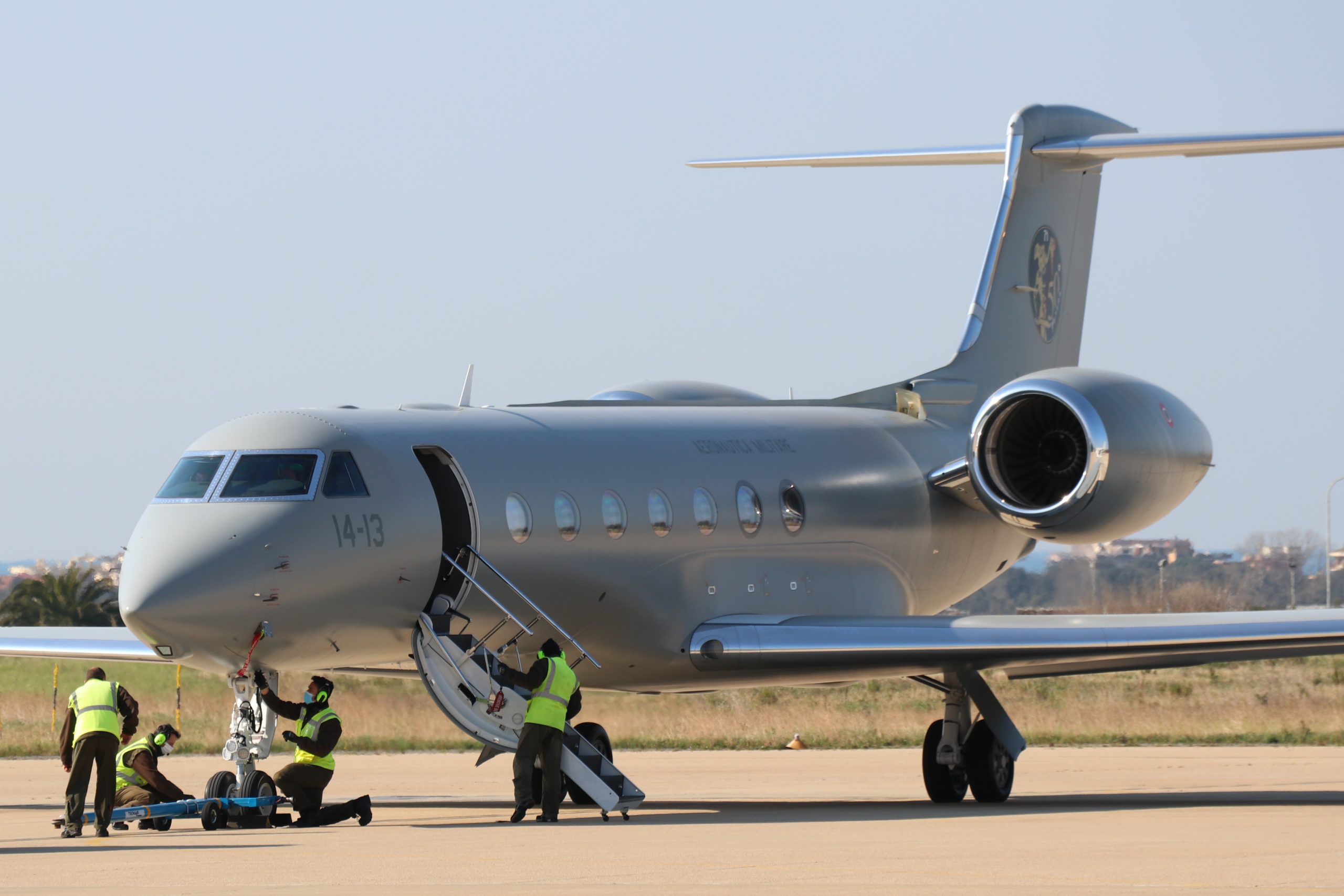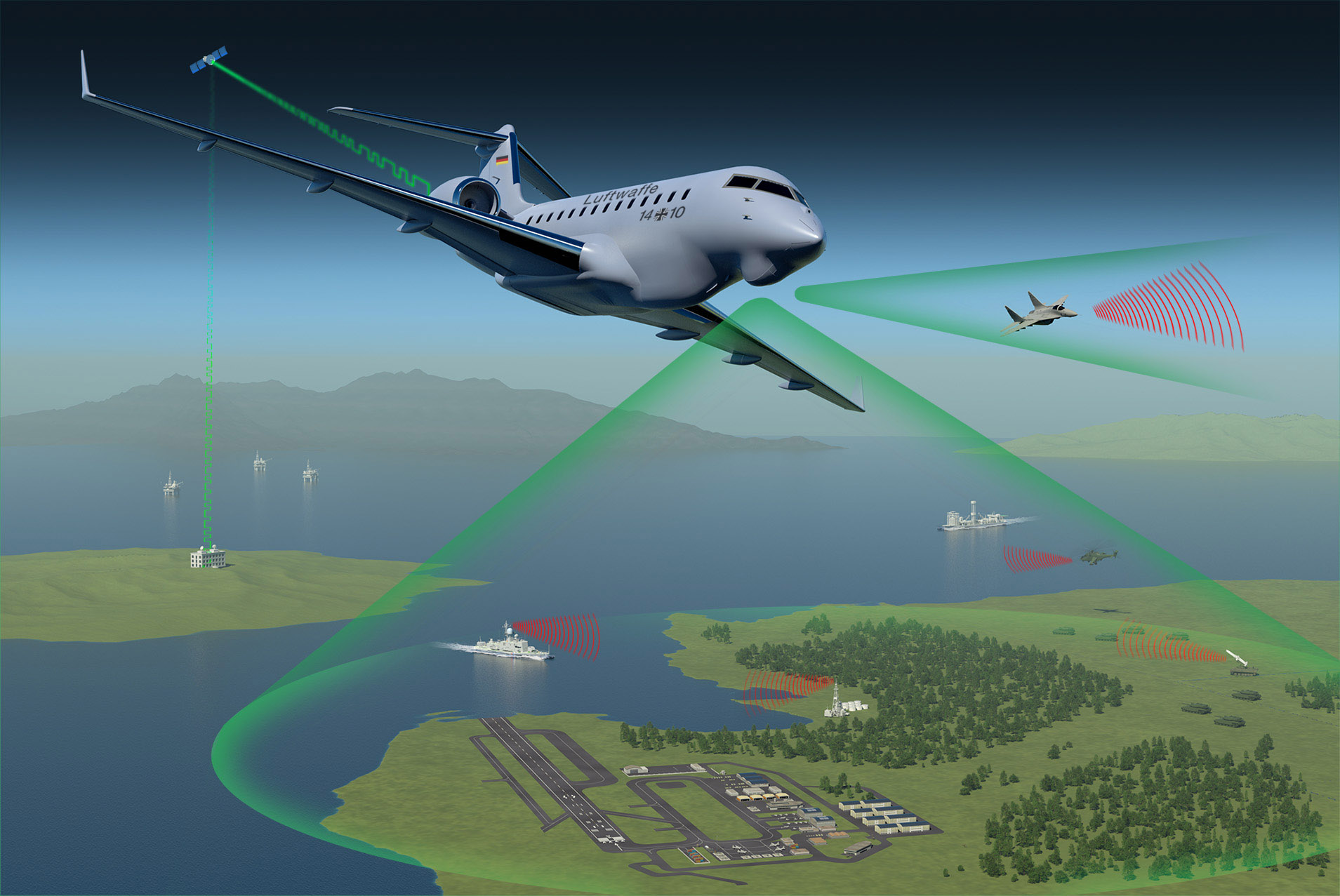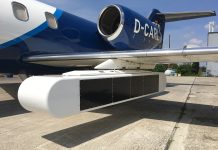The recent Russian invasion of Ukraine has seen the consistent deployment of Intelligence, Surveillance and Reconnaissance (ISR) platforms. Operations against peer- and near-peer adversaries require high-altitude and deep-sensing intelligence to ensure wide coverage and survivability, but also deep electronic support which is being offered by modified long-range business jets equipped with sophisticated surveillance and electronic warfare (EW) suites.
In recent years, these ISR platforms have enlarged their customers’ fleets and the market for them is significantly growing, notwithstanding the diffusion of unmanned aerial systems. In large part this is due to their long range, large cabin, electrical power and ready availability of commercial off-the-shelf spares, sustainment support and different operating schemes, including direct or contractor management and ownership. Key characteristics to accomplish ISR missions include the capability to fly at altitudes of 15.24 km (50,000 ft) at high speeds, above commercial air traffic, and providing reduced transit time to the area of operations (AO). A further benefit of flying at higher altitudes is that doing so lowers the radar/optical horizon and provides a greater field of regard for the aircraft’s electronic, radar and optical sensors, allowing a larger area to be surveyed in a single mission.
In terms of the manufacturers for the host platforms, some of the main contenders in the field include Gulfstream Aerospace, Bombardier Defense, and Dassault Aviation. Gulfstream Aerospace is a wholly-owned subsidiary of General Dynamics, and has delivered more than 200 special mission aircraft to support government and militaries in over 40 countries. Most notable in this category was the G550 platform, which found use in a varied range of missions. However, after nearly two decades in service, production of the G550 has now been completed, following final deliveries in 2021. Despite this, numerous examples remain in service, and Gulfstream is in the process of deciding a successor among its available platforms. Bombardier Defense has already delivered over 550 aircraft for specialised missions, and is presently offering its families of Challenger and Global aircraft. Dassault Aviation has delivered 250 Falcon multi-role aircraft worldwide, and is presently promoting the Falcon 2000 and 900 series platforms, the latest addition being the Falcon 8X.
USA
In October 2021, L3Harris Technologies (L3Harris), the platform integrator and prime contractor for the US Air Force’s next generation EC-37B Compass Call EW platform, announced the completion of the first flight of the aircraft’s first flight. Under this programme, L3Harris is migrating the Compass Call EW suite from the legacy EC-130Hs into the newer Gulfstream G550 business jets. BAE Systems is the mission systems integrator and provider of the redesigned and enhanced mission suite, making it the US DoD’s only long-range, full-spectrum stand-off EW jamming platform. With increased speed, endurance, and extended stand-off range over the legacy EC-130H, the hardware migration programme envisions a fleet of 10 EC-37B aircraft providing the equivalent EW capacity as the original high-demand 14 EC-130H original fleet.
The EC-37B exploits the modification work initially applied to the Conformal Airborne Early Warning (CAEW) G550-based platform in service with Israel, Singapore, and Italy’s air forces, as well as the US Navy in the form of the NC-37B missile range support platform, which is intended to perform surveillance and monitoring of missile tests. In September 2022, BAE Systems announced that they had delivered key components for the first aircraft, paving the way for developmental and operational flight testing of the Baseline 3 configuration (for the first five aircraft) of the Compass Call from early 2023. Interim fielding is expected to follow the completion of testing by mid-2024.
Under a contract signed in June 2021 for the US Air Force (USAF) Battlefield Airborne Communications Node (BACN) programme, Bombardier Defense delivered the first of up to six additional modified Global 6000 aircraft in the E-11A configuration in September 2022. These will be added to the four already in service, which have been delivered by Bombardier under previous agreements since 2007. The E-11A is equipped with the BACN mission suite provided by Northrop Grumman to act as airborne relay that extends communications ranges, bridges between radio frequencies and ‘translates’ among incompatible communications systems, enhancing tactical and situational awareness, as well as communications and coordination for joint and coalition forces.

In September 2022, the US Army awarded L3Harris and Raytheon Applied Signal Technology the phase 2 contracts for the Multi-Domain Sensing System (MDSS) programme. This aims to demonstrate, develop, build, and integrate prototype ELINT and COMINT sensors onto the High Accuracy Detection and Exploitation System (HADES), the service’s next-generation airborne ISR system. The US Army is pursuing HADES to address the demands of future Multi-Domain Operations (MDO) against peer- and near-peer adversaries. HADES will be globally deployable and provide a multi-faceted sensing capability at higher altitudes and longer ranges, and with longer endurance than is currently available from the Army’s RC-12 Guardrail, MC-12 EMARSS and EO-6C ARL aircraft.
The goal is to provide deep-sensing intelligence collection of indicators and warnings, electronic order of battle, and patterns of life for targeting. Thanks to the contract, the two companies will further develop and build their sensors, which will be flight tested during Phase 3 and then procured and installed on a long-range high-altitude business jet. Until it is delivered, the US Army is collecting feedback and bridging aerial surveillance needs with three technology demonstrator programmes:
1. The Airborne Reconnaissance and Targeting Multi-Mission System (ARTEMIS)
2. The Airborne Reconnaissance Warfare System (ARES).
3. The Army Theater Level High-Altitude Expeditionary Next Airborne ISR Radar (ATHENA-R).
ARTEMIS and ARES are respectively based on the Leidos-owned and operated Bombardier Challenger 650 with a mission suite currently flying in Europe, and a Bombardier Global Express 6500 jet equipped with an L3Harris suite deployed to the Pacific. The soon to-be tendered ATHENA-R programme for the supply of a batch of contractor-owned, contractor-operated business jet equipped with an ISR suite is attracting several bidders. L3Harris and MAG Aerospace announced a teaming agreement based on a Global 6500, Sierra Nevada unveiled the rapidly configurable RAPCON-X platform in August 2022, also based on a Global 6500, while Leidos could offer a further development of its Bombardier Challenger 650-based ARTEMIS II solution on the more capable Global 6500 platform.
Australia
In 2019, the Australian Ministry of Defence announced that the Department was buying four modified Gulfstream G-550 business aircraft under the Project Air 555 programme. Designated the MC-55A ‘Peregrine’, it has been described as a highly capable, full-spectrum intelligence, surveillance, reconnaissance, and electronic warfare (ISREW) platform. The aircraft is intended to provide a critical link between platforms, including the F-35A Joint Strike Fighter, E-7A Wedgetail, EA-18G Growler, the Navy’s surface combatants, amphibious assault ships and ground assets. At present, all four aircraft are being converted and subjected to a flight-test programme scheduled to be completed in mid-2023. The first aircraft is expected to be delivered to the Royal Australian Air Force in late 2023.

Credit: L3Harris
These platforms are being modified and equipped with ISREW equipment by L3Harris under contract from the USAF’s 645th Aeronautical Systems Group, also known as ‘Big Safari’. The latter has extensive knowledge in the design and development of airborne electronic intelligence platforms in a classified environment. Although few details were provided on the mission suite, based on the external modifications from previous programmes (namely the CAEW G550, the US Navy NC-37B and USAF EC-37B Compass Call), the MC-55A ‘Peregrine’ is reported to be equipped with a SIGINT package, alongside a Leonardo Osprey 50 AESA radar suite with distributed arrays, an optronic infra-red (IR) gimballed sight in a dome-shaped housing (located under the aircraft’s bulbous rear tail cone fairing), wideband secure SATCOM data link and radio communications, in addition to a self-protection suite. The platform is reported to have EW capability, including electronic attack, in order to support Royal Australian Air Force (RAAF) offensive and deep-strike missions. Deliveries are slated for completion in 2025.
Israel
Among the most prolific worldwide developers of special mission aircraft (SMA) from business jets and military aircraft conversion, Israel Aerospace Industries’ (IAI) Elta Systems division together with national industry is proposing a range of solutions including the ELW-2085 CAEW, ELW-2090 AWACS, P-600 AEW, ELI-3001 SIGINT, ELI-3150 Multi-Mission Airborne Reconnaissance & Surveillance System (MARS2), ELI-3150 ISTAR and ELI-350 CL650 aerial ground surveillance (AGS) multi-mission aircraft.
The ELW-2085 CAEW is based on Gulfstream G550, and is in service with Israeli, Italian and Singaporean air forces. It is characterized by low-drag conformal radomes accommodating the latest generation AESA dual-band (L/S band) radar, ESM/ELINT, communications with wideband secure SATCOM and data link, in addition to a self-protection suite. Elta also developed the ELI-3001 SIGINT, which is also based on the Gulfstream G550 platform. It includes Elta’s latest ELINT and COMINT sensors and 10 multi-mission operator stations which manage radio, satellite communications and data links, and a self-protection suite. The ELI-3150 MARS2 is another G550-based platform, equipped with a sophisticated AESA multi-mode radar suite with air-to-ground, air-to-sea and air-to-air capabilities, an integrated SIGINT suite with ELINT/COMINT systems, all managed by a C2 suite based on 4-to-6 operator workstations, in addition to a communications suite including SATCOM data links. This platform is capable of carrying two ISR pods under its wings. Elta also offers the ELI-3150 ISTAR model, which can be based on either the Bombardier Global 6500 or Challenger 650 platform, and is equipped with Elta’s sensors and systems including multi-mode AESA radar, SIGINT and long-range multispectral optronic IR system, and self-protection suites, all managed by 4-6 operator workstations.

Credit: Israeli Air Force
In addition to the Nachshon Eitam ELW-2085 CAEW G550s and the Nachshon Shavit SIGINT platforms based on Gulfstream V, the Israeli Air Force officially introduced the Nachshon Oron G550 based platform in April 2021. A joint development by the Israeli MoD, Armed Forces and industry, the Nachshon Oron will reportedly perform different missions, and is equipped with a latest-generation AESA radar suite incorporating air-to-ground and air-to-sea modes, SIGINT sensors and self-protection systems. The aircraft also possesses a communication suite which includes flying relay station capabilities to support joint operations. Capable of accommodating a large team of operators, it is also reported to be capable of providing targeting in support of ground operations, as well as EW capabilities. Since its arrival in Israel, the first of an undisclosed number of aircraft began the mission system installation, integration and qualification process, which understood to require two years before the aircraft is ready for operations.
Italy
In February 2021, the Italian Parliament approved the JMMS (joint airborne multi-sensor multi-mission system) multi-phase programme for eight platforms to undertake a wide range of missions including ISREW, AEW&C and EW. According to available information, the Italian MoD has selected the Gulfstream G550 platform, which is already in service with the Italian Air Force in the CAEW variant, with two aircraft delivered respectively in 2016 and 2018 by IAI/Elta Systems. The EUR 1.2 Bn multi-year programme covers the procurement of the first two aircraft as dedicated platforms, as well as an additional six ‘green’ airframes to be later converted to JMMS platforms.

In March 2022, the Italian MoD awarded Elta Systems a EUR 209 M contract for the procurement of two additional G550 CAEW to cover multiple theatres of operations. The follow-on programme phase regarding the procurement of mission suites for the four previously acquired JMMS airframes was approved by Italian Parliament in late 2021. No contract details were released but in December 2020 the US State Department approved a potential Foreign Military Sale (FMS) to Italy for airborne ISREW (AISREW) mission systems to be installed on two G550 aircraft provided by Italian MoD for an estimated cost of USD 500 M, with L3Harris Technologies listed as prime contractor. According to US documentation, the mission suite is centred on L-3 Rio COMINT suite (two installed, two spares), Leonardo Osprey 50 AESA radar and L3 Harris MX-20HD multispectral optronic sight, additional unspecified ISR equipment and Link 16 MIDS, alongside other communications, Identification Friend or Foe (IFF) systems, and a self-protection suite. The first of two aircraft to be converted to the AISREW configuration arrived in Italy in March 2022, and are to be used for training until the modification works begin. More recently, the Italian Air Force’s Chief of Staff declared that an unspecified number of the remaining ‘green’ airframes will be converted to an electronic-attack-capable model such as the EC-37B Compass Call for the US Air Force. Should Italy decide to go for this configuration, it would need US approval to obtain them.
France
On December 2019, the French Armament General Directorate awarded Dassault Aviation and Thales the contract for the ARCHANGE (Avion de Renseignement à CHArge utile de Nouvelle Genération; ENG: Intelligence Aircraft with New-Generation Payload) programme. Launched in November 2019, it concerns the development and delivery of a new airborne SIGINT capability to replace the two then-in service Transall C-160 Gabriel dedicated platforms. Dassault Aviation is modifying and equipping the Dassault’s Falcon 8X aircraft with the CUGE (Capacité Universelle de Guerre Electronique; ENG: Universal Electronic Warfare Capability) SIGINT suite under development by Thales. The initial contract is for two modified aircraft, but the programme also calls for an additional platform plus a ground training system.

According to French MoD documentation, the ultra-long range Falcon 8X tri-engine platform will offer two-to-three times the endurance of the C-160 Gabriel in the area of operations, in addition to extended range. The three new aircraft will allow the French MoD to regain the strategic SIGINT capability offered by the C-160 Gabriel plus the DC-8 Sarigue platforms, the latter retired in 2004. Although few details were disclosed, being capable of concurrent ELINT and COMINT missions, the integrated CUGE suite features sophisticated digital technologies and long-range, highly sensitive sensors capable of detecting modern low probability of intercept signals, namely through Thales’ multi-polarisation antennas. In future, it will use artificial intelligence to automate large amount of data processing. The integrated data processing and distribution suite will allow almost real-time information processing and sharing.
Due to high operating costs and low availability of remaining C-160 fleet, the French MoD decided to retire their C-160 Gabriel aircraft in May 2022, along with the rest of the fleet. The country’s first new SIGINT platform will be commissioned in 2026, a year later than initially planned. To fill the gap, the French MoD launched a tender to loan a Saab 340 twin-engine turboprop platform, capable of carrying out missions lasting seven to eight hours, equipped with a modern SIGINT suite. This platform will work alongside the country’s Beechcraft Super King Air-350 VADR ISR aircraft, Rafale fighters equipped with the ASTAC pod, MQ-9 Reaper UAVs, and the CERES satellites until the ARCHANGEs arrive.
Germany
A new milestone in the PEGASUS (Persistent German Airborne Surveillance System) programme led by Hensoldt was reached in November 2022, when the first of three Global 6000 aircraft arrived at Bombardier’s Wichita facility in Kansas, USA, on 28 November to perform structural modifications to accommodate Hensoldt’s SIGINT suite. In June 2021, the Hensoldt received a contract from Germany’s BAAINBw defence procurement agency, for the development and delivery of three SIGINT platforms centred on the Global 6000 platform, equipped with the Hensoldt ‘Kalætron Integral’ suite. German company Lufthansa Technick, along with Hensoldt, is responsible for the integration of the SIGINT suite on board the three aircraft in Germany. Modifications are due to take place once Bombardier Defence completes their structural modifications, testing and certification in the US.

Presented for the first time at Paris air show 2019, according to the few details provided by Hensoldt, the Kalætron Integral suite can conduct both ELINT and COMINT operations simultaneously using a single system. Kalætron Integral detects emissions over an extremely wide frequency range and thanks to automated resource allocation and software-defined tasks, it can detect, analyse, monitor, and evaluate interaction between radio emissions. It can also use intelligence (AI) algorithms to identify new threat patterns from collected raw data, depicting the enemy electronic order of battle during the mission. According to the latest German MoD documentation, the PEGASUS will reach initial operational capability in 2025 while the full operational capability is planned for mid-2027.
Thanks to this programme, the German MoD will regain a strategic capability which was lost in 2010 with the retirement of the Breguet Atlantic SIGINT platforms. Previously the German MoD has been working on the Global Hawk unmanned platform, but concerns about full European Union Aviation Safety Agency certification achievement in the required timescale, higher costs, operational analysis together with parts commonality with in-service VIP transport aircraft, pushed the MoD toward a manned solution.
Other Programmes Worldwide
In Europe, the Swedish Air Force is using two Gulfstream S102B Korpen SIGINT platforms based on the Gulfstream IVSP aircraft to monitor the War in Ukraine. In June 2022, The Swedish Defence Materiel Administration (FMV) contracted Saab to deliver two customised GlobalEye Airborne Early Warning Control (AEW&C) aircraft based on the Bombardier Global 6000, with deliveries planned for 2027, and an option for additional two platforms.
On March 2019, the Turkish Presidency of Defence Industries (SSM; now Defence Industry Agency (SSB)) announced that two green Bombardier Global 6000 airframes were delivered to Turkish Aerospace (TAI) to undergo modification to the Hava SOJ (Air Stand-off Jammer) configuration developed by Aselsan, the prime contractor. Deliveries of the first two platforms are expected in 2023.

Italian company Elettronica is offering the ELT/819 ELINT suite, whose modular architecture allows to be configured for various requirements. In addition to tactical intelligence with warning and self-protection capability and accurate data analysis for intelligence-gathering, it can also accommodate COMINT/CESM capabilities. According to Elettronica, the ELT/819 is part of an unspecified likely multi-sensor suite installed on Bombardier Global Express platforms for an undisclosed customer in the Middle East region.
Saudi Arabia has a small fleet of RE-3A/B Tactical Airborne Surveillance System (TASS) platforms based on the modification of up to three Boeing KE-3A tanker/cargo aircraft in service with the Royal Saudi Air Force. Externally resembling the RC-135 Rivet Joint and equipped to conduct SIGINT operations, these platforms are aging, and US companies L3 Harris and BAE Systems reportedly offered a replacement based on the Gulfstream G550 in an unspecified AISREW configuration.
Under the Project Dolphin, the UAE Armed Forces acquired and put into service two Bombardier Express platforms which were modified by Marshall Aerospace and Defence Group. Their configuration reportedly included ELINT/COMINT capabilities and a long-range oblique photography camera in addition to a self-protection suite. They join the five Saab GlobalEye AEW&C Global 6000-based platforms due for delivery.
In the Asia-Pacific region, India’s foreign intelligence agency, the ‘Research and Analysis Wing’ (R&AW) operates two Bombardier Global 5000 which were converted in Israel and equipped with a mission suite reportedly including an Elta ELI-3001 Airborne Integrated Signal Intelligence System (AISIS), together with radar, optronic IR sight, and self-protection suite, making the aircraft a multi-purpose intelligence-gathering platform.
Luca Peruzzi








